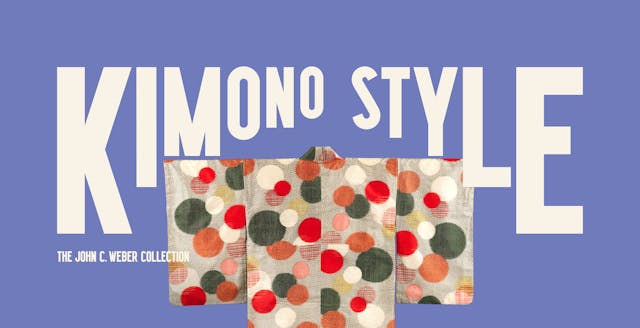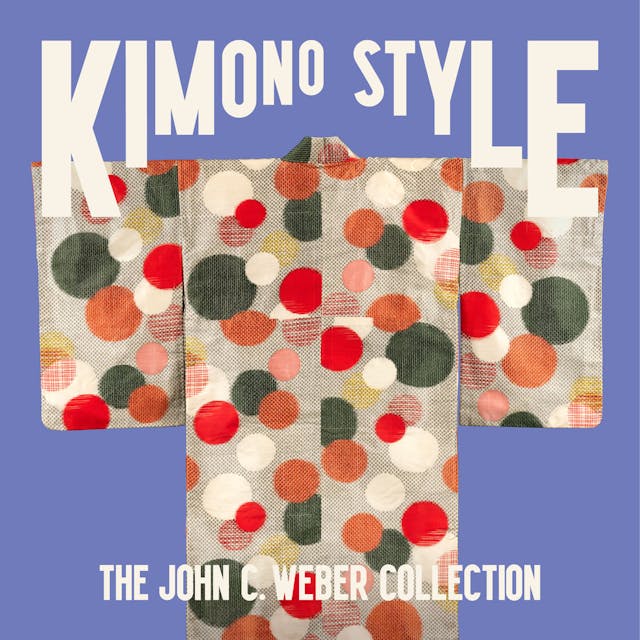

Exhibition
Kimono Style: The John C. Weber Collection
Objects on view
Noh Costume (Karaori) with Dharma Wheels and Clouds
Japan
mid-18th century
Kyōgen Suit (Suō) with Rabbits Jumping over Waves
Japan
mid-19th century
Kyōgen Suit (Suō) Jacket with Gourd Vines
Japan
first half 19th century
Netsuke of Usofuki Mask
Japan
mid-19th century
Netsuke of Mask for the Noh Play Okina
Ishimine
mid-19th century
Inrō with Sanbasō Dancers
Japan
first half 19th century
Inrō with Noh Masks
Japan
first half 19th century
Mask for the Noh Play Okina
Shibata Zeshin (Japanese, 1807–1891)
dated 1879
Bag for Noh Mask
Japan
18th century
Bag for a Noh Mask with Flowers and Geometric Patterns
Japan
first half 19th century
Ko-omote Noh Mask
Japan
18th century
Chūjō Noh Mask
Genkyu Michinaga (Japanese, active second half of the 17th century)
18th century
Headband (Kazura-obi) and Sash (Koshi-obi) with Ivy
Japan
late 18th–early 19th century
Poem from the Meager Gleanings (Shūi gusō)
Hon'ami Kōetsu (Japanese, 1558–1637)
ca. 1620s–1630s
Small Shoulder Drum (Kotsuzumi) with Chestnuts for Noh Performance
Japan
early 17th century
Small Shoulder Drum (Kotsuzumi) with Hydrangeas for Noh Performance
Japan
17th century
Six Noh Performances in Scenes from Daily Life
Japan
late 17th–early 18th century
Chūkei Fan with Queen Mother of the West and King Mu of Zhou (obverse) and Plum Tree and Young Pines (reverse)
Japan
first half 19th century
Libretto for the Noh Play Eguchi ( Kōetsu utaibon Kokatsuji ban "Eguchi" ) 光悦謡本 古活字版 " 江口"
Unidentified artists Japanese
ca. 1605
Vest (Kataginu) Ensemble with Trivets
Japan
first half 19th century
Noh Costume (Nuihaku) with Orchids and Interlinked Circles
Japan
18th century
Noh Costume (Atsuita) with Checkered Ground and Chrysanthemums in Stream
Japan
18th century
Noh Headdress with Auspicious Motifs
Japan
early 19th century
Noh Play Scene from the series Pictures of Noh Plays (Nōgaku zue)
Tsukioka Kōgyo (Japanese, 1869–1927)
1897–1902
Banner with Shōki, the Demon Queller
Utagawa (Gountei) Sadahide (Japanese, 1807–1873)
1840s
Kosode Pattern Book (On-Hiinagata) vol. 1
Japan
1667
Kosode Pattern Book (On-Hiinagata), vol. 2
Japan
1667
Order Book of Kosode Patterns (Chūmon no hiinagata/Hiinagata chūmon chō)
Imura Katsukichi (Japanese, active early 18th century)
1716
Contemporary Kimono Patterns (Tōsei hiinagata) 当世ひいな形
Hishikawa Moronobu 菱川師宣 (Japanese, 1618–1694)
1677
The Cloth-Fulling Jewel River, a Famous Place in Settsu Province (Tōi no Tamagawa, Settsu no meisho), from an untitled series of Six Jewel Rivers (Mu Tamagawa)
Suzuki Harunobu (Japanese, 1725–1770)
ca. 1766–67
Young Women Playing Cat’s Cradle (Ayatori)
Suzuki Harunobu (Japanese, 1725–1770)
ca. 1765–66
Beauty of the Kanbun Era
Japan
late 17th century
Figure of a Standing Beauty
Japan
ca. 1670–90
Over Robe (Uchikake) with Willow and Poem
Japan
second half 18th century
Over Robe (Uchikake) with Bamboo and Folded-Paper Butterflies
Japan
first half 19th century
Over Robe (Uchikake) with Mount Hōrai
Japan
mid-19th century
Banyan and waistcoat
French
ca. 1730
Amusements in a Mansion
Japan
mid-17th century
Daimyo Firefighter’s Ensemble (Kaji shōzoku)
Japan
first half 19th century
Daimyo Firefighter’s Ensemble (Kaji shōzoku) for Samurai Woman
Japan
first half 19th century
Fireman’s Jacket (Hikeshi-banten) with Shogun Tarō Yoshikado
Japan
mid-19th century
Fireman’s Jacket (Hikeshi-banten) with Chinese Warrior
Japan
mid-19th century
Shirt
Various Artists
1976 (textile); ca. 2003 (shirt)
The Battle at Ichinotani, from The Tale of the Heike (Heike monogatari)
Japan
17th century
Fireman’s Jacket (Hikeshi-Banten) with Susanoo-no-mikoto Deity Scene
Japanese
mid-19th century
Battle Flag (Sashimono) with Nine-Circle Crest
Japan
first half 19th century
Battle Flag (Sashimono) with Five-Element Stupa
Japan
first half 19th century
Stirrups (Abumi) with Cosmetic Brushes
Japan
late 17th century
Saddle (Kura) with Stylized Flowers
Japan
Saddle: Muromachi period (1392–1573), dated 1491 (Entoku 3); lacquer decoration: Edo period (1615–1868), 17th century
Battle Surcoat (Jinbaori) with Tattered Fan
Japan
early 19th century
Battle Surcoat (Jinbaori) with Fan
Japan
first half 17th century
Ainu Coat (Kaparamip)
Japan
early 20th century
Farmer’s Jacket (Shigotogi)
Japan
second quarter 20th century
Fisherman’s Jacket (Donza) with Geometric Patterns
Japan
early 20th century
Summer Kimono with Pine Lozenge and Cherry Blossoms
Japan
early 20th century
Outer Robe (Katsugi) with Chrysanthemum Crest
Japan
first half 19th century
Picture Book of Mount Asaka (Ehon asakayama) 絵本浅香山
Nishikawa Sukenobu 西川祐信 (Japanese, 1671–1750)
1739
One Hundred Women of Japan (Wakoku hyakujo) 和国百女
Hishikawa Moronobu 菱川師宣 (Japanese, 1618–1694)
ca. 1695
Vest
Japan
first half 19th century
Ensemble
Various Artists
fall/winter 2016–17
Cosmetic Box (Mayudzukuri-bako) with Pine, Bamboo, and Cherry Blossoms from a Wedding Set
Japan
early 19th century
Obi (Kakeshita-obi) with Shell-Matching Game Boxes
Japan
late 18th century
Summer Robe (Katabira) with Stream and Plum Trees
Japan
first half 19th century
Summer Robe (Katabira) with Kemari Balls and Willow
Japan
late 18th–early 19th century
Summer Robe (Katabira) with Irises at Yatsuhashi
Japan
mid-19th century
Over Robe (Uchikake) with Genji Wheels and Wild Ginger Leaves
Japan
early 19th century
Dressing gown
Japanese
1896–98
Kimono
(attributed) Iida & Co./Takashimaya (Japanese, founded 1831)
ca. 1910
Tea gown
British
1898–1901
Opera coat
Paul Poiret (French, Paris 1879–1944 Paris)
1911
Court Lady’s Garment (Kosode) with Swallows and Bells on Blossoming Cherry Tree
Japan
mid-19th century
Ladies Sewing (Kijo saihō no zu)
Adachi Ginkō (Japanese, 1853–1902)
September 3rd, 1887
Paper Doll Clothing
Unidentified artist
1897–98
Insignia of the Order of the Golden Kite
Japan
late 19th century
Insignia of the Supreme Order of the Chrysanthemum
Japan
late 19th century
Insignia of the Order of the Precious Crown, Paulownia
Japan
late 19th century
Summer Kimono (Hito-e) with Swirls
Japan
1920s–30s
Summer Kimono with Banana Leaves
Japan
1920s–30s
Meisen Summer Kimono with Comma (Tomoe) Patterns
Japan
ca. 1930s
Pajamas
Callot Soeurs (French, active 1895–1937)
1926–27
Look 25
Thom Browne (American, born 1965)
spring/summer 2016
Man’s Under Kimono (Nagajuban) with Spider and Spiderweb
Japan
1920s–30s
Coat
Liberty & Co. (British, founded London, 1875)
late 19th–early 20th century
Shelf for Cosmetic Boxes (Kurodana) with Wild Grapevine and Family Crest
Japan
first half 17th century
Box for Accessories (Sumiaka-tebako) with Chrysanthemums and Autumn Grasses
Japan
late 16th century
Evening dress
Various Artists
1926–27
Evening dress
Attributed to Callot Soeurs (French, active 1895–1937)
ca. 1925
Summer Kimono (Hito-e) with Waves and Waterdrops
Japan
1920s–30s
Man’s Under Kimono (Nagajuban) with Mount Fuji
Japan
second quarter 20th century
Child’s Winter Kimono with Mickey Mouse
Japan
ca. 1930s
Dress
Charles James (American, born Great Britain, 1906–1978)
1956
A Seven-Character Calligraphy
Sekishitsu Zenkyu (Japanese, 1294–1389)
14th century
Incense Burner in the shape of a Rabbit
Japan
15th century
Black Seto Tea Bowl
Japan
16th century
Tea caddy (chaire)
Japan
early 17th century
Freshwater Jar (Mizusashi)
Japan
17th century
Kettle (Kama) with Stripes and Rhomboid Pattern
Hata Shunsai III 三代畠春斎 (Japanese, born 1974)
2020
Evening dress
Various Artists
1917
Textile Pattern Sample Book
Japan
mid-19th century
Girl Carrying a Parasol
Unidentified artist
early 20th century
Obi with Peonies, Fans, and Dewdrops
Japan
mid-19th century
Practical Sketchbook (Ōyō manga) 応用漫画
Ogino Issui 荻野一水 (Japanese, active early 20th century)
1903
Obi Sash with Pines, Cranes, Chrysanthemums, and Auspicious Motifs
Japan
early 20th century
Formal Obi Sash for a Wedding with Cranes, Court Carriages, and Auspicious Motifs
Japan
early 20th century
Woman in Summer Kimono
Hashiguchi Goyō (Japanese, 1880?–1921)
June 1920
Woman Dressing
Hashiguchi Goyō (Japanese, 1880?–1921)
1920
Early Spring, from the series Shōwa Beauties and Their Fashions (Senshun: Shōwa bijin fūzoku)
Ito Shinsui (Japanese, 1898–1972)
1941
Meisen Jacket (Haori) with Looped Lines
Japan
ca. 1950–55
Meisen Kimono with Water Droplets
Japan
ca. 1930–40
Ensemble
Issey Miyake (Japanese, 1938–2022)
spring/summer 1979
Meisen Kimono with Diamond Patterns
Japan
ca. 1950–55
Meisen Kimono with Large Checkered Pattern
Japan
ca. 1930s
Meisen Kimono with Stylized Windows
Japan
ca. 1950–55
Evening dress
Various Artists
spring/summer 1935
Meisen Kimono with Thunderbolts
Japan
ca. 1950–55
Necklace
American
1930–39
Hat
Sally Victor (American, 1905–1977)
1936
Evening scarf
Various Artists
1925–30
Meisen Summer Kimono with Rabbits and Scouring Rushes
Japan
ca. 1930s
Meisen Kimono with Origami Cranes (Orizuru)
Japan
ca. 1945–55
Ensemble
Various Artists
1979
A Visit to the Yoshiwara
Hishikawa Moronobu 菱川師宣 (Japanese, 1618–1694)
late 1670s–early 1680s
Kabuki Actor Ichikawa Danzō III
Katsukawa Shunshō (Japanese, 1726–1792)
ca. 1760s
Kabuki Actor Ichikawa Monnosuke II
Katsukawa Shun'ei (Japanese, 1762–1819)
ca. 1793
Kabuki Actor Ōtani Oniji III
Katsukawa Shun'ei (Japanese, 1762–1819)
ca. 1792
Kabuki Actor Segawa Kikunojō III
Katsukawa Shunshō (Japanese, 1726–1792)
ca. 1777
Kabuki Actor Nakamura Denkurō II
Katsukawa Shunshō (Japanese, 1726–1792)
ca. 1770s
Kabuki Actor Nakamura Nakazō I
Katsukawa Shunkō (Japanese, 1743–1812)
4th month, 1783
Kabuki Actors Sawamura Sōjūrō III and Segawa Kikunojō III
Katsukawa Shunshō (Japanese, 1726–1792)
ca. 1780
Kabuki Actor Osagawa Tsuneyo II
Katsukawa Shunshō (Japanese, 1726–1792)
1787–88
Kabuki Actor Azuma Tōzō III
Katsukawa Shunshō (Japanese, 1726–1792)
probably 1782
Book of Painted Kosode Patterns
Japan
second half 17th century
Book of Painted Kosode Patterns
Japan
second half 17th century
Connoisseur's Book of Silk Fragments
Japan
late 19th century
Foreign Business Establishment in Yokohama (Yokohama ijin shōkan shashin no zu)
Utagawa (Gountei) Sadahide (Japanese, 1807–1873)
1861
Foreign Business Establishment in Yokohama (Yokohama ijin shōkan uriba no zu)
Utagawa (Gountei) Sadahide (Japanese, 1807–1873)
9th month, 1861
Foreigners Enjoying a Party (Gaikokujin yūkyō no zu)
Utagawa Yoshitora (Japanese, active ca. 1850–80)
1st month, 1861
Dutch Woman and Child (Seisha ikoku jinbutsu Oranda fujin aijidō no zu)
Utagawa (Gountei) Sadahide (Japanese, 1807–1873)
1860
American Woman Riding Side-Saddle on the Road at Honmoku, Motomura, Yokohama (America Yokohama Motomura Honmoku michi)
Utagawa Hiroshige II (Japanese, 1826–1869)
2nd month, 1861
Russians Enjoying a Holiday in Yokohama (Yokohama kyūjitsu Roshiajin yūkō)
Utagawa (Gountei) Sadahide (Japanese, 1807–1873)
1861
French Woman and Girl, from the series Foreign Merchants in Yokohama (Yokohama shōka ijin no zu)
Utagawa (Gountei) Sadahide (Japanese, 1807–1873)
1st month, 1861
Foreign Family with Wife Making Clothes (Gaikokujin ifuku shitate no zu)
Utagawa Yoshikazu (Japanese, active ca. 1850–70)
1860
"SUMIE"
Various Artists
1989
Evening cape
Charles James (American, born Great Britain, 1906–1978)
ca. 1944
"Parts Knit"
Issey Miyake (Japanese, 1938–2022)
fall/winter 1985–86
Bustier
Yohji Yamamoto (Japanese, born Tokyo, 1943)
fall/winter 2006–7
Bodice
Issey Miyake (Japanese, 1938–2022)
fall/winter 1980–81
Kit
Various Artists
spring/summer 1999
Evening ensemble
Various Artists
fall/winter 1983–84
Dress
Various Artists
fall/winter 2012–13
Evening dress
Madame Grès (Germaine Émilie Krebs) (French, Paris 1903–1993 Var region)
1967
Evening dress
Various Artists
1950
Dress
Various Artists
spring/summer 1990
Evening ensemble
Various Artists
1966–69